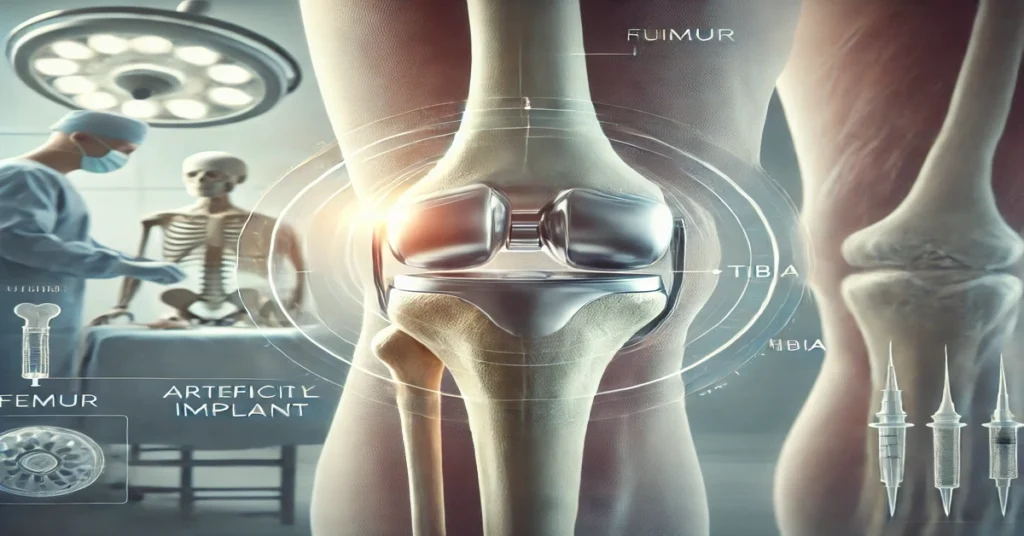Introduction
Knee replacement surgery is a common yet complex procedure aimed at relieving pain and restoring function in severely damaged knee joints. This article will explore various aspects of knee replacement surgery, from reasons for surgery and procedure details to post-operative care and common mistakes to avoid during recovery.
Section 1: What is Knee Replacement Surgery?
Knee replacement surgery, also known as knee arthroplasty, involves removing damaged cartilage and bone from the knee joint and replacing it with an artificial joint made of metal and plastic. There are different types of knee replacement surgeries:
- Total Knee Replacement (TKR) – the most common type where the entire knee joint is replaced.
- Partial Knee Replacement (PKR) – only part of the knee joint is replaced.
- Bilateral Knee Replacement – both knees are replaced, either simultaneously or in a staged manner.
- Revision Knee Replacement – done if the original replacement wears out or fails.
Each type has its own set of indications, recovery times, and potential risks.
Section 2: Why People Undergo Knee Replacement Surgery
Indications for Knee Replacement: Knee replacement is generally recommended when non-surgical treatments fail to alleviate severe pain and mobility issues. Common reasons include:
- Osteoarthritis: The primary cause of knee damage, resulting in pain, stiffness, and decreased mobility.
- Rheumatoid Arthritis: An autoimmune disorder causing chronic inflammation in joints.
- Post-Traumatic Arthritis: Resulting from an injury, leading to damaged cartilage.
- Other Joint Deformities: Such as bow legs or knock knees, which may strain the knee joint.
Benefits of Knee Replacement Surgery
Knee replacement surgery can significantly improve the quality of life by reducing pain, enhancing mobility, and allowing patients to resume daily activities.
Section 3: Preparing for Knee Replacement Surgery
Medical Preparations
- Consultations and Tests: Patients usually undergo a series of tests, including blood tests, X-rays, and sometimes MRI scans, to assess the knee joint.
- Medical History Review: Doctors need to review the patient’s complete medical history, including any medication or supplements taken.
- Pre-Surgical Physical Therapy: Known as “prehab,” strengthening exercises help build muscle to support the new joint.
- Medications Adjustment: Some medications need to be stopped before surgery, such as blood thinners.
Lifestyle Preparations
- Home Adjustments: Setting up a recovery area on the main floor, installing grab bars, and arranging for help with daily tasks.
- Dietary Adjustments: Ensuring optimal nutrition for healing, often involving increased protein, vitamins, and hydration.
Section 4: The Knee Replacement Procedure
The surgery generally takes 1 to 2 hours, depending on the type and complexity. Here’s a step-by-step outline:
- Anesthesia Administration: Patients receive either general or spinal anesthesia.
- Incision and Removal of Damaged Tissue: The surgeon makes an incision in the knee to remove damaged cartilage and bone.
- Implant Placement: Metal components are cemented to the ends of the thigh and shin bones.
- Insertion of Plastic Spacer: A high-grade plastic spacer is placed between the metal components to allow smooth joint movement.
- Closure: The incision is closed with sutures or staples, and the area is bandaged.
Section 5: Post-Operative Care and Recovery
Recovery after knee replacement surgery involves several stages, each with specific guidelines to ensure proper healing.
Immediate Post-Operative Care
- Hospital Stay: Typically 1 to 3 days, depending on the procedure and the patient’s condition.
- Pain Management: Using medications and cold therapy to manage post-surgical pain.
- Physical Therapy Initiation: Physical therapy starts soon after surgery, with exercises to regain motion and strength.
Recovery Timeline and Rehabilitation
- Weeks 1-2: Focus on basic movement and exercises to increase flexibility. Walking with assistance is encouraged.
- Weeks 3-6: Progressing with more intense exercises; most people can walk without assistance by the end of this period.
- Months 3-6: Continued strength-building; most patients achieve near-normal activity levels.
- 6 Months to 1 Year: Full recovery, although some may feel minor stiffness or discomfort that usually resolves.
Physical Therapy Exercises
Key exercises include ankle pumps, heel slides, and stationary cycling. Strength training for the quadriceps, hamstrings, and glutes also plays a crucial role in recovery.
Section 6: Complications and Risks of Knee Replacement Surgery
Knee replacement surgery is generally safe, but there are potential risks:
- Infection: Ranging from mild to severe, sometimes requiring further surgery.
- Blood Clots: Patients may be prescribed anticoagulants to prevent deep vein thrombosis (DVT).
- Nerve Damage: Rare but can cause tingling or numbness around the knee.
- Implant Loosening or Failure: Leading to pain and potentially requiring revision surgery.
How to Minimize Risks
- Follow Doctor’s Orders: Adhere to all post-surgical guidelines.
- Regular Check-ups: Early detection of complications through follow-up appointments.
- Good Hygiene: Preventing infection by keeping the wound clean.
Section 7: Top 5 Mistakes to Avoid After Knee Replacement
- Skipping Physical Therapy: Physical therapy is crucial for restoring mobility and strength. Avoiding it can lead to stiffness and limit recovery.
- Not Using Assistive Devices: Walking aids like canes or walkers help avoid putting too much pressure on the healing knee.
- Overexertion: Trying to do too much too soon can damage the new joint.
- Ignoring Pain or Swelling: Pain is an indicator that something may be wrong. Ignoring it can lead to complications.
- Poor Diet: A nutritious diet is essential for healing. Skimping on nutrients can delay recovery.
Conclusion
Knee replacement surgery is a life-changing procedure that can restore function, relieve pain, and significantly improve a patient’s quality of life. Following the correct preparation, procedure, and recovery steps can help ensure a successful outcome.
Frequently Asked Questions (FAQs)
Q1: How long does a knee replacement last?
Most knee replacements last between 15-20 years, depending on factors like activity level and weight.
Q2: When can I return to work after knee replacement surgery?
This varies by individual and job type, but most people return to work within 6-12 weeks.
Q3: Will I need another knee replacement in the future?
Possibly, if the implant wears out or if there are complications, especially in younger, more active patients.
Q4: Can I kneel after a knee replacement?
Kneeling may be uncomfortable and should be avoided initially. Consult with your doctor or physical therapist.
Q5: What exercises should I avoid after a knee replacement?
High-impact exercises like running or jumping should be avoided to preserve the artificial joint.
Q6: What is the average cost of knee replacement surgery?
Costs vary by region and provider, but it can range from $30,000 to $50,000 without insurance.







